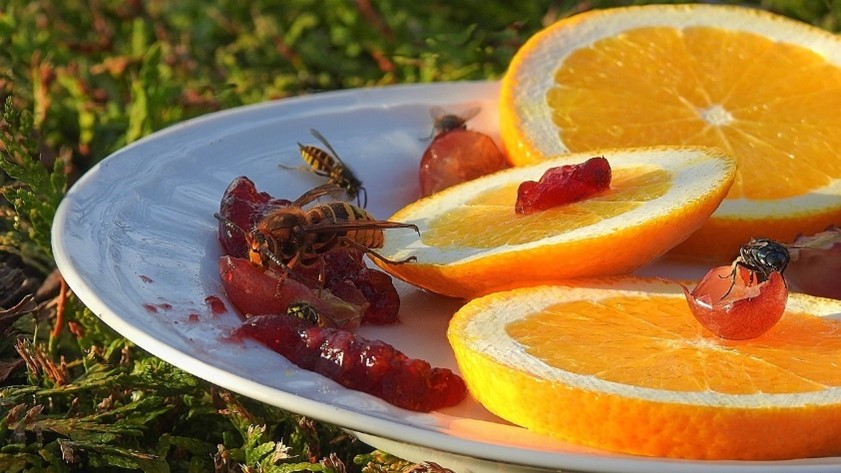
The warm seasons bring sunshine and outdoor fun, but they also bring increased activity from stinging insects like bees, wasps, hornets, and yellowjackets. While these insects play vital roles in the ecosystem, they can pose significant risks to human health and safety, particularly when they nest close to human habitats. Understanding the behavior of these aggressive stingers and taking proactive measures to manage them can help you enjoy the warmer months in peace and safety.
In Colorado, the four main types of stinging insects you’re most likely to encounter are:
Honey Bees – Honey bees are hairy and exhibit an orange or yellow-orange hue, though some may be dark gray. They are generally not aggressive and will only sting to defend their colony. Most stings happen accidentally, such as when someone steps on a bee while barefoot or traps a bee in their clothing. Bees foraging on flowers are not prone to attack and play a crucial role in pollination. They are usually not considered pests. Bees have a barbed stinger that remains embedded in the skin, leaving behind a poison sac and causing the bee to die after stinging.
Wasps – Wasps, including species like paper wasps, are recognized for their distinctive nests made from a paper-like material created from chewed wood fibers mixed with saliva. Unlike bees, wasps can sting multiple times during an encounter, making them particularly daunting when disturbed. They also serve as important pollinators; though less effective than bees, wasps frequent various plants and contribute to the pollination process.
Yellowjackets – These are a type of ground-nesting wasp that can be very aggressive, especially near food or when their nests are disturbed. They are commonly seen during the later summer and early fall. Yellowjackets are particularly attracted to human food, making outdoor events like picnics and barbecues prime encounters with these bold and defensive insects.
Hornets – Specifically, the bald-faced hornet, which is actually a type of yellowjacket, is noted for its large size and distinctive, white-marked face. Hornets build large, visible nests and can be quite aggressive if their space is infringed upon. Additionally, bald-faced hornets prey on other insects, helping to control pest populations.
Controlling Stinging Insects & Removing Their Nests
Controlling and removing wasp and hornet nests from your property requires careful planning and execution to ensure safety and effectiveness. Before attempting any removal, it’s crucial to correctly identify the species, as this will influence the approach and timing. If the nest is small and relatively accessible, you can use an over-the-counter wasp or hornet spray. These insecticides are designed to be applied from a distance, allowing you to spray the nest from several feet away. Aim to soak the nest thoroughly, preferably at night when wasps and hornets are less active. It’s important to check the nest the following day and reapply if necessary.
For larger nests or those situated in difficult-to-reach areas, or if you’re allergic to stings, it’s safer and more prudent to call Front Range Pest. We have the expertise, equipment, and protective gear needed to manage the removal effectively and minimize the risk of stings. Additionally, we can provide advice on preventing future infestations, such as sealing entry points in your home’s exterior and maintaining a clean environment free of food residues that might attract these insects.
Bees are generally non-aggressive and should be preserved when possible. For hives that are too close for comfort (located near a busy entryway, playground, etc.) contact us or a local beekeeper for rehoming. It’s important to relocate their entire nesting habitat, as any remaining wax combs and honey may damage your home’s structure, but also attract rodents and other insects.
Reducing the Presence of Stinging Insects
Maintain Your Yard: Regular yard maintenance can reduce nesting opportunities for stinging insects. Keep your garden tidy, mow the lawn regularly, and trim bushes and trees away from your home.
Manage Attractants: Be mindful of exposed food during outdoor activities. Cover food containers and dispose of garbage promptly in sealed trash bins to avoid attracting yellowjackets and other pests.
Seal Entry Points: Inspect your home for cracks and small openings. Wasps and hornets can create nests in wall cavities or under eaves. Sealing these points can prevent them from establishing nests inside or near your dwelling.
When Stings Happen
Despite all precautions, stings can happen. It’s essential to know how to respond:
- Remain calm and slowly move away from the area to avoid provoking further stings.
- Check to see whether the stinger is still in the skin. A bee’s barbed stinger typically remains embedded in the skin, while wasps may only leave their stingers behind if they’re swatted away and the stinger breaks off in the skin. If a stinger is present, remove it with tweezers.
- Treat the sting site with ice to reduce swelling and alleviate pain. Leave the ice in place for five minutes to reduce blood flow, which helps your body’s defensive action against the venom.
- Ibuprofen, Benadryl, or acetaminophen can help reduce pain. Apply Calamine lotion to the affected area throughout the day to decrease itching. Scratching the affected area may spread the venom, thus lengthening the healing process.
- Monitor for allergic reactions, such as difficulty breathing, swelling of the face or throat, or rapid heartbeat. Seek immediate medical attention if any of these symptoms occur.
Do not attempt to remove an aggressive stinging insect hive yourself! Contact the experts for prompt, safe removal!
Front Range Pest is your trusted, family-owned pest and wildlife control company serving central Colorado and southern Wyoming. Our certified technicians have the expertise and credentials to ensure effective pest management for your home or business. As your all-in-one insect and wildlife specialists, we offer peace of mind by identifying wildlife entry points, removing nuisance pests, sealing access areas, performing cleanup, and making essential repairs. Schedule an inspection with us today.
Written by the digital marketing team at Creative Programs & Systems: www.cpsmi.com